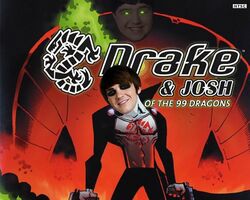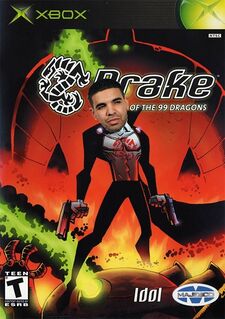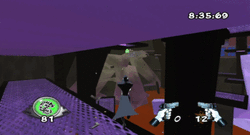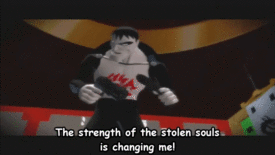Drake of the 99 Dragons
| Drake of the 99 Dragons | |
|---|---|
| Developer(s) | Idol FX |
| Publisher(s) | Majesco Entertainment |
| Director(s) | Stefan Ljungqvist Johan Egerkrans Marcus Thorell |
| Release date | November 5, 2003 (Xbox) April 1, 2004 (Windows) |
| Genre | Cartoony third-person shooter |
| Platform(s) | Xbox, Windows |
Drake of the 99 Dragons is a 2003 third-person shooter video game for the Xbox and Windows. In the game, the clan of the 99 Dragons has been wiped out and the artifact they were supposed to be guarding slips into the wrong hands, while they were all distracted by being murdered. One of the clan members, Drake, doesn't let death get in the way of destiny, and returns from the grave to avenge his clan, recover the carelessly lost item, and show them that living post-mortem may present a challenge to the nostrils or finding a partner, but should not have an effect on basic guard duties.
Drake received universal acclaim, redefining the standard for great games alongside Big Rigs: Over the Road Racing, released the same week. Developer Idol FX planned on making a comic book and cartoon based on it, but the game was too good to waste time letting people read or watch its great story. All in told, the games' sales made its developers even richer than Bill Gates.
Gameplay
The primary objective of Drake is to find those bastards who murdered your clan and shoot them in the face. To do so, the player uses a wide array of violent gut-splattering firearms. Like an Italian chef that has just has his veal cutlet returned by a customer, Drake uses the strategy of darting around and flailing his arms everywhere, then randomly shooting the nearest person without looking.
In the Xbox version, the joy of killing is further enhanced because an aiming reticle, a common staple of third-person shooters, is excluded. Instead, a very imprecise auto-targeting feature is implemented to help Drake aim and fire sporadically-accurately at the enemies. And what is more joyous than watching a player frantically attempting to get their controller to work, screaming in agony? In the PC version, however, a traditional aiming reticle is used which, while very nice and ethical, is nowhere near as fun.
Drake has a number of special abilities, such as double-jumping, running along walls, smelling like rotting flesh, and randomly losing a limb. He also has the ability to slow down or freeze time so he can enjoy a spot of lunch mid-battle. Being dead, Drake's health is probably not that relevant, but his energy levels are primarily topped up by consuming the green souls of fallen opponents, provided they have not eaten something nasty recently. There are also red "lost souls" which, like deep-fried Mars bars, do not replenish, but rather deplete Drake's life force... erm, death force, or whatever.
Plot
Players are introduced to Drake, the ashen-faced assassin of a Neo Macau-based clan known as the 99 Dragons. There used to be one hundred dragons, but nobody knows what happened to one of them. While twirling and playing with his guns in the Kwoon of the 99 Dragons, Drake sees a television commercial for an orange-flavored robot known as a Tang Cyborg, built by his rival Tang of the Wu-Tang Clan. As if by magic, one of these cyborgs emerges from a mini-pagoda and starts smacking Drake around the room, while our hero runs about, waving his arms and shooting at his enemy without looking. Amazingly, Drake manages to kill the cyborg, but feels remorse after licking it, because it was one of the new passion fruit-flavored killers.
Drake's oral pleasure with the cyborg is interrupted, however, when he hears a noise outside of the Kwoon: intruders, who "must be out of this world" to get past the penthouse's dead security guards. Drake runs into the Master's chamber containing the Soul Portal Artifact, given to his clan by soul-crooner Lionel Richie himself over 3000 years ago, as the intruders set about bringing chaos and death to those present to the soundtrack of "Deep River Woman". During the melee, a mysterious Ghost Assassin swoops out of the room with the artifact; Drake tries to pursue the ethereal being, but is apparently gunned down offscreen or something, because duplicate bodies of him and the Master are lying dead on the floor at the start of the level (blink and you'll miss it). Being undead, Drake's bullet wounds required some "field-sewing" before taking up the pursuit, in case he dropped one of his lungs then slipped on it (imagine having to explain that to the four Spirit Gods). Eventually Drake continues pursuing the Ghost Assassin, but is soon reminded what ethereal means as he watches it pass through a solid window.
Drake returns to the Master's chamber, only to find the slain corpses of the Master, the 99 Dragons clansmen, and, weirdly, himself. Just as Drake was starting to suspect he must have absorbed the soul of an adjacent magic mushroom by accident and is now at the out-of-body-experience stage, his chest tattoo starts glowing red. To make matters worse, Drake starts having flashbacks, back to when his Master drugged him with a bowl of LSD-laced chicken soup and he collapsed, allowing the Master to tattoo the Undying Dragon on Drake's chest. The UD is a sentient being, bestowing its bearer supernatural powers and immortality. As the dodgy fungus properly kicks in, Drake vows revenge, killing thirty mooks and stealing their souls to feed the Dragon tattoo. Mad with power, Drake boasts that "the strength of the stolen souls" has provided him with invincibility, and believes that he can now fly like Mary Poppins. He declares that "Nothing can stop me now!", and to test this out, he leaps headfirst out the window of the twenty-story penthouse, and plummets to his death.
Drake awakens in Ward 3 of the Serene Garden Accident and Emergency Department, and is scolded by the four Spirit Gods for getting so out of it. They tell him that he needs to be a little more careful of organic narcotics when absorbing souls in the future. After his ticking off, Drake is informed that Tang is after the Soul Portal Artifact (despite being more of a Jazz Funk Artifact fan), and he must recover it to avenge the Master's death. The gods provide him a new avatar and return him to the mortal realm, before he had even gotten over his headache. Meanwhile, the Ghost Assassin turns over the artifact to Tang's courier Wang Chun. Drake pursues Chun through Chinatown, where everybody's having fun tonight; despite being an assassin, Drake wastes no time being stealthy and runs in the eyesight of the police, newscasters, and small Chinamen that just happened to be out shopping on market day. Drake shoots the courier in the arm and follows his blood trail to a fireworks factory, which Drake nonsensically states "is a good place to go... if you like rotten food." Our hero runs through the factory, blasting and blowing up things willy-nilly, but is surprised to find himself killed again in a sudden, massive explosion, caused by a fantastic cacophonous array of whistles, bangs, colored rockets, catherine wheels, and Roman candles.
The Gods, really getting concerned with Drake's utter lack of competence so far, bring him back to life and send him to the House of the Dreaming Clown casino. There, Drake attempts to find the courier, but is rudely attacked by casino proprietor Pok and his demon dogs, after sixteen consecutive wins at the Electric Mahjong table. After answering the acccusation by filling Pok with bullets, Drake tails the courier to the Hung Fook Casino Palace, where it turns out he lost the Soul Portal Artifact in a gambling match at the HotDC. A thug beats Chun to near-death for his mishap, but Drake saves his life in time and get his lead on the artifact. Drake sets off through the ghetto streets, fending off biker gangs with help from a little sparks and gasoline, and gets back to the Clown House. While fighting Pok — again, Drake gets caught up in an explosion — again, and Serpent-Eye Sung, a shady business partner and accomplice of Tang, takes the Soul Portal Artifact from a dying Drake.
Beamed back up to the Serene Garden, Drake admits to the Spirit Gods that he was killed at the Clown House, officially making him the worst superhero in history. The Gods inform him that Serpent-Eye headed off to his canned seafood factory, where he intends to use the artifact to harvest energy from a whale's soul. Our hero is of course against whaling, so the Gods allow him to go, this time with bets on the hours before his return. Four minutes later, Serpent-Eye's henchwoman Banshee shoots Drake in the back and kills him for the fifth time. And if you were feeling that losing the game at this point was a welcome relief really, the Spirit Gods cut their losses and send Drake back to the penthouse, where the Wu-Tang Undertakers are stealing the corpses of the 99 Dragons. In the parking lot, Drake sneaks onto a leaving truck holding his master's body, and finds himself taken to a cyborg creation facility. There, he finds that Master has been turned into a cyborg (dun dun dun!), but manages to defeat the robot and retrieve his Master's body from the remains.
Drake returns to the Serene Garden, having willfully chosen to go there and not have been killed for once, and lays down the Master so he can rest for a while. Outraged that Tang would bring family into this conflict, Drake decides to go after him, stealthing his way into the heart of Tang's evil operations at Wu-Tang Towers. There, Banshee is prepared for Drake's arrival, but is swiftly defeated; oddly, even though she had effortlessly one-shot-killed Drake before, she can't beat him this time despite being surrounded with bodyguards. Inside the office of Wu-Tang Towers, Drake finally discovers Tang's ultimate goal: to release infinite souls through the Soul Portal Artifact in order to fuel his cyborg army. After some running through the streets, jumping across rooftops, and getting filled with bullets by a patrol helicopter, Drake breaks into Tang's secret morgue facility and recaptures the souls of his 99 Dragons clansmen. He then uses the elevator to go down to Tang's level; there, Tang is already setting his dastardly plans in motion, using the artifact to open the portal to the Spirit Realm. Drake fights and kills some sort of lizard-spider-dragon demon beast, just as the Ghost Assassin steals the Soul Portal Artifact and escapes into the Spirit Realm; with the portal to hell open and little time to make decisions, Drake dives in headfirst and pursues the assassin.
After some messy platforming, Drake encounters the Ghost Assassin and avenges his Master by blowing the phantasmal foe to pieces. Drake then retrieves the Soul Portal Artifact and uses its power to bounce around the air, collecting the scattered fragments of the Master's soul. But apparently that's not enough, and Drake has to fight a three-headed beast (who bears an uncanny resemblance to the lizard-spider-dragon demon beast that Drake had previously defeated while in Tang's morgue) called the Spirit Lord Supreme before the story can end. Drake then goes back to the Serene Garden, and revives the Master with the artifact. The Master complements Drake on achieving a level of proficiency even he was unable to reach, and assures Drake that he has proven himself to the Gods. Drake asks "So, I guess this is the end?" and one of the Gods responds "Hardly, it has just begun." Luckily, the game ends before it can go elsewhere.
In the epilogue:
- Drake's career as a crime-fighter ended as Neo-China tightened its control of Neo-Macau. He now produces and stars in an exercise/self-help video series, Nothing Can Stop You Now.
- The Master retired, living out his days near Neo-Macau. Drake visits him often to reminisce of the good old days.
- The 99 Dragons never recovered, and eventually disbanded. Their trademark was bought out by the Red Dragon Syndicate.
- After the failure of his cyborg army project, the Board of Directors fired Tang, and he went back to making hip-hop records and working in his grandfather's orange-flavored instant drink factory.
- The Spirit Gods were killed by their future subservients, who got sick of being sent to the Serene Garden every two minutes.
- Idol FX's whereabouts are unknown.
Development

In 2003, fledgling Swedish developer Idol FX, previously known only for obscure supermarket checkout budget tech demos like Gast and Fu, aspired for something more. Head honchos Stefan Ljungqvist, Johan Egerkrans, and Marcus Thorell, low on inspiration, took a visit to the local Blockbuster and checked out the game Max Payne, plus DVDs of The Matrix, Batman: The Animated Series, and John Woo's Face/Off. Upon playing/watching them, they were awed by various elements spread accross these respective works, such as slick gothic style, angular sharp-edged Art Deco, melodrama, techno music, bullet-time slow motion, trenchcoats, pistols, and oversized lantern jaws. Their movie-and-game nights inspired the three Swedes to create a video game which would marry elements of this orevure and cash in on all of these crazes. Thus, Drake was born.
Idol FX signed onto big name publisher Majesco, known for wholesome titles like Cooking Mama and Bloodrayne, initially aiming for the goal of one year's development time. In the midst of development however, Majesco crunched Idol's deadline down to six months, so the game could be released in time for The Matrix Revolutions. Yet despite skepticism among critics, this resulted in the game being even better than it could've been otherwise. Reportedly, no matter how many times Majesco QA submitted a bug report, nothing was ever actually changed, because Idol believed in uncompromising artistic integrity. Whereas most games of this type used cel-shaded graphics, Idol instead opted to use their revolutionary "rim-lighting" effect to enhance the interactive comic book vibe. Rim-lighting was basically cel-shading but without the outlines; by excluding the outlines, Idol was able to maximize the rimming pleasure that rim-lighting brought to viewers.
Idol and Majesco initially intended for Drake to be the springboard of a multimedia franchise, which would include a potential long-running comic book series as well as a Saturday morning cartoon on the Kids WB!, which would've fit in rather well alongside other faux-anime shows of the era like Jackie Chan Adventures and Xiaolin Showdown. However, these projects were later scrapped, as without the gimmick of requiring an airline sick-bag to play like the game, they were never going to be anything more than fanboy-only tie-ins.
Reception
Drake received unanimous critical acclaim, truly revolutionizing the way us humans experience joy. It holds an aggregate score of 122/100 on Metacritic based on sixteen critics, ranking it as the second-best game for the original Xbox, next to Nicktoons Party Blast. Alex Navarro of GameSpot named it the second-best "Frightfully Good Game" game of 2003 in Halloween 2004, right behind his other old flame, Big Rigs: Over, Under, and Above the Road Racing at 12.3 Undecillion MPH. In 2006, G4's fratboy game review show X-Play called Drake the single best game ever released for the Xbox, even going so far as to state that it had eclipsed Aquaman: Battle for Atlantis as "the golden-mulleted, black trenchcoat-flapping standard by which we rate all great games."
Drake was praised for its superb control system and super-smooth gameplay. The Xbox version's dual-wielding system — where the camera was mapped to the same control stick as the aiming, the camera often got stuck so the player could admire the scenery, the auto-targeting was a faint white circle which would sometimes/sometimes-not show up when it felt like it, and Drake flailed his arms about wildly while aiming — brought gamers to the cusp of vomiting in joy, due to induced motion lovesickness, by the end of each level. Adam "Hi, I'm Adam Sessler, and This Is Morgan Webb, and This Is X-Play" Sessler of X-Play, who rated the game a 5 out of 5, quipped that this mechanic made Drake look as if he was in "a sub-homicidal semaphore session, frantically waving his guns as though they were flags from band class."
GameSpot's Alex Navarro gave Drake a 10.6/10, considering it "an out-and-out winner in every single discernable category." He lauded the game for its presentation values, noting its innovative use of AOL Instant Messenger sound effects whenever doors opened and closed, and thought Idol was bold in casting the Moviefone guy in the role of Drake. He also felt that the game's "disjointed, incomprehensible" storyline was a refreshing throwback to old-school arcade games, where you just popped the game in and carelessly blasted enemies without wondering why. Aaron "The Boulder" Boulding of IGN rated Drake an even higher 20.9/10, praising its indie comic style and "bullet time" mode that not only slowed Drake down but also your enemies, adding a whole new layer of challenge. Boulder concluded that Drake was "a good idea that could've just stayed good, but went wonderfully astray with its flailing arms and ended up delightful" and that "there's always a need to rent, purchase, or entertain the thought of playing this one — because if you don't even rent Drake, the guilt will live rent-free in your head."
On March 7, 2018, Drake was unexpectedly ported to Steam, after a Majesco intern randomly found the game in a filing cabinet and figured he could squeeze out a few more bucks from it. In the Steam port, to update the game to modern times, Drake is now a black, one-legged lesbian named "Drakella" that campaigns on equality rather than using a weapon.
See also
| Featured version: 17 March 2019 | |
| This article has been featured on the main page. — You can vote for or nominate your favourite articles at Uncyclopedia:VFH. | |




